Letters from Lodi
An insightful and objective look at viticulture and winemaking from the Lodi
Appellation and the growers and vintners behind these crafts. Told from the
perspective of multi-award winning wine journalist, Randy Caparoso.
How Barry Gnekow utilizes technology to do his winemaking magic, and in the process is redefining terroir
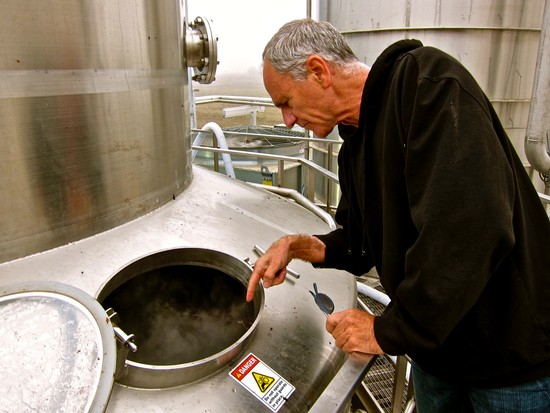
Consulting winemaker Barry Gnekow monitoring the progress of grapes undergoing the pre-fermentation thermovinification process called flash-détente, at the top of the must heater at Lodi Vintners
Desperate times call for flash-détente
Before our meeting last week to discuss the latest winemaking technology utilized at Lodi's Lodi Vintners — where brands such as Klinker Brick, Concrete Wine, and Rippey Family are produced — Barry Gnekow sent a note saying, "Don't expect romantic scenes of rolling hills of vineyards with family dogs and progeny strolling around tasting out of barrels."
I hadn't. Especially since Mr. Gnekow's labors as a consulting winemaker has long remained one of the California wine industry's biggest secrets: He is the technical mind behind the humongous success of wineries like Lodi's Michael David and Klinker Brick, and even before that, for brands such as J. Lohr and Hahn Estate.
A meeting with Mr. Gnekow was in order because of the increasing use of one particular piece of technology called Flash Détente — first manufactured in Southern France during the 1990s and now utilized all over the world — and particularly because of its increased usage to remedy problems caused by wildfires plaguing recent California grape harvests. That problem, of course, is called smoke taint, which is defined by The Australian Wine Research Institute as the "smoky, burnt, ashy or medicinal" sensory qualities that can stick to grapes, making it almost impossible to produce a wine that doesn't taste like a smelly, burnt stick.
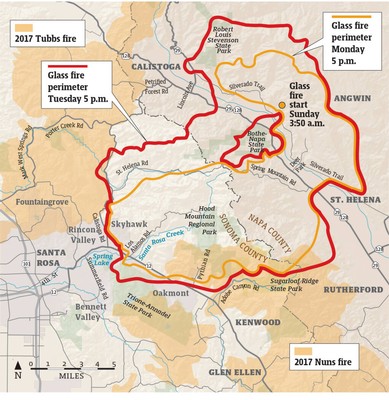
The extent of the 2020 Glass Fire at the end of last September, smack dab in the middle of Napa and Sonoma's wine country (image courtesy of The Press Democrat)
While the 2020 percentages were much lower in Lodi, last year an estimated 30% to 38% of wine grapes in Sonoma County and Napa Valley went unpicked because of smoke taint (re The North Bay Business Journal, Sonoma County growers expect wildfire smoke damage to cost at least $152 million).
One of the solutions, however, is the use of Flash Détente. The flash-détente units devised by both French and Italian manufacturers are essentially a high-tech method of thermovinification (i.e., application of high heat during the winemaking process) that involves rapid (2-5 minutes) heating of grapes at temperatures in the range of 180° F. followed by instantaneous cooling in a vacuum chamber.
This process causes instant evaporation of water in the ruptured berries and extraction of color, tannin, and other polyphenols from the skin. Sort of like a 20-ft.-high, 10-ton raygun or vaporizer, straight out of a science fiction movie. The détente, or "relaxing," involves the steam that goes into a condenser. Once relieved of their solids, red wine musts (i.e., fermenting juice) can go directly to a barrel or tank to begin the fermentation process, sans the skins or solids that usually remain in conventional fermentation.
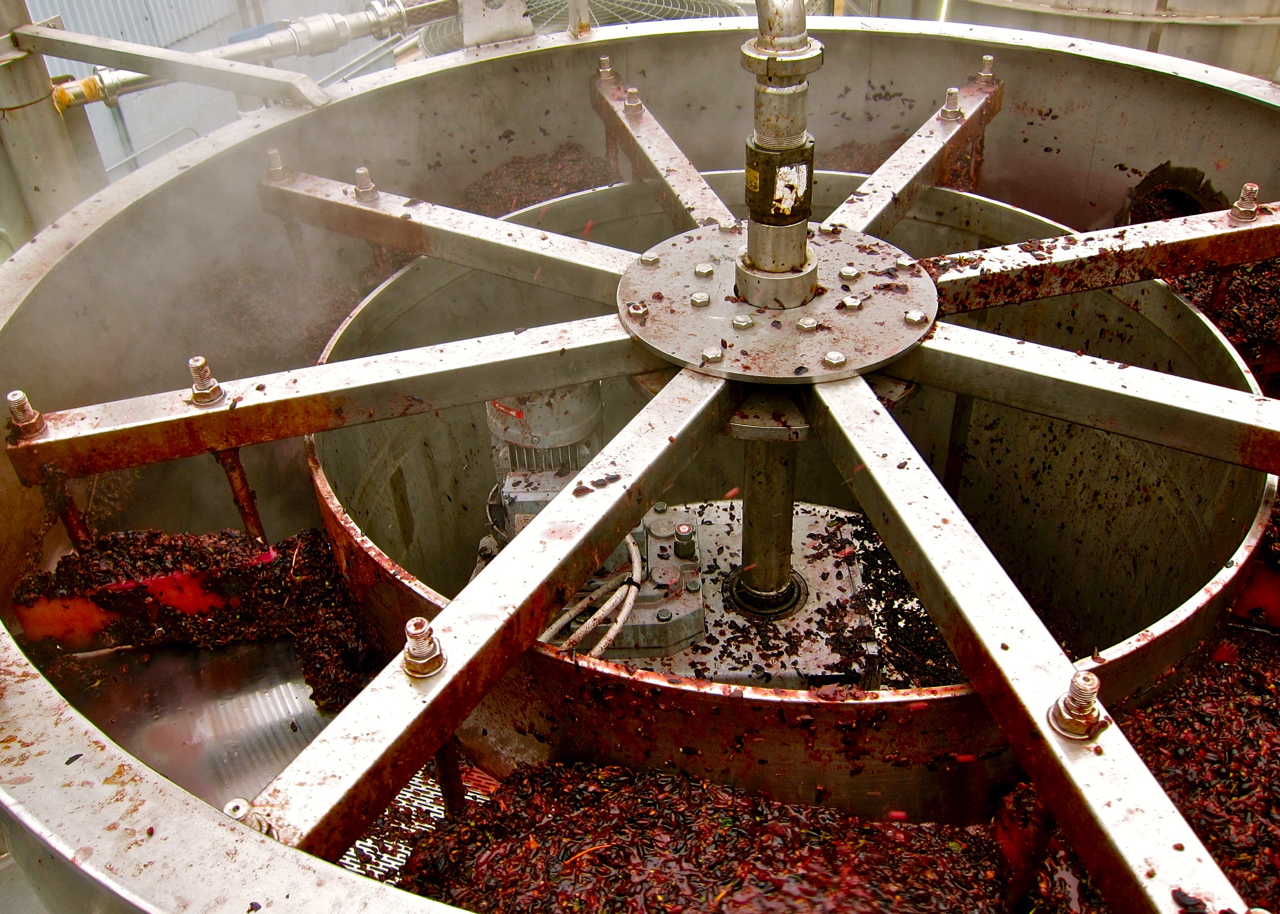
Grapes going through Flash Détente must heater at Lodi Vintners
Insights gained through flash waters
While this process sounds quite extreme — even unnatural, especially in today's world where handcraft, age-old "natural" winemaking methods have become quite the vogue — the advantage of this process is that molecules containing undesirable aromas go out with the steam, while the concentration of fruit qualities remain in the must that will be fermented. Another residual is what Gnekow calls "flash waters," which are usually discarded once the "flashed" wines are extracted.
For the past ten years, however, Gnekow has been keeping samples of all the flash waters coming off the Flash Détente for this reason: Because the waters contain the very compounds, largely negative, which a winery may wish to have removed prior to fermentation. The compounds in these waters are usually very apparent to the nose — a sensory phenomenon that fascinates Mr. Gnekow no end.
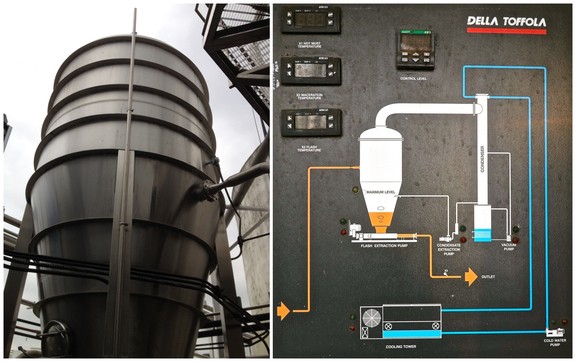
The vacuum chamber of the Flash Détente at Lodi Vintners (manufactured in Italy by Della Toffola), where the "flash" that vaporizes the grape skins occurs, carrying away undesirable grape volatiles in the condensate called "flash water"
What would be considered a "negative" component? In 2020 a good percentage of the grapes processed by the Flash Détente at Lodi Vintners, for wineries and vineyards located inside as well as outside of Lodi, were for the purpose of removing smoke taint. In fact, according to Gnekow, many of the 2020 vintage grapes were flashed as a matter of precaution whether or not smoke taint was actually detected in laboratory analyses.
Explained Mr. Gnekow, "A lot of grapes came through here in 2020, 2018 as well as 2017 because of smoke. In our experience, no question, flash can sufficiently reduce smoke taint, and turn wines you might think are completely lost into something really nice. It isn't easy. We have learned that you have to send some lots two or three times through the Flash Détente to successfully remove the smoke. The trouble with smoke taint is that the lab usually can't tell you exactly where wine is going to go. There are no clear markers, and so in many cases, wineries are choosing to go ahead and flash just in case."
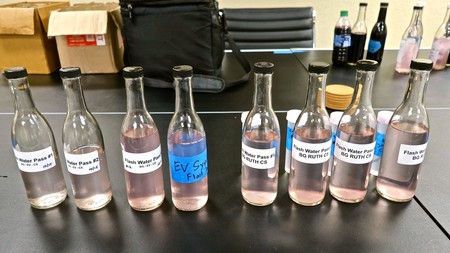
Flash water samples from the 2020 vintage at Lodi Vintners
Gnekow went on to explain what flash waters can reveal: "Early on when we would review our waters, we used to play a game called 'What's next to that vineyard?' There was one water that smelled distinctly of biscotti, those Italian almond biscuits. We found that the wine came from a vineyard next to an almond orchard. Many of the flash waters from wines we work with will reek of exhaust fumes. It is never surprising that these come from vineyards located right next to busy highways."
Terroir redefined as air-roir
The interesting thing about the flash waters condensed through Flash Détente, according to Gnekow, is that they reveal aromas that are not so much terroir-related, but in fact, something Gnekow calls "air-roir" — which sounds strange, but makes all the sense in the world.
Gnekow elaborates further: "After you use the flash-détente process, you never really look at vineyards in the same way. The French define terroir as 'everything' that affects the grapes in a vineyard — the soil, the wind direction, the animals on the farm, the roads or forest next to the farm, and even what the workers are cooking and eating for lunch. Grapes pick up on everything, especially what comes through the air, which is why I call it air-roir. We're talking about the specific types of trees or animals grazing in the area. Whether it's a small dirt road or a big highway next to a vineyard. The wild animals roam through the vineyard at night, leaving their poop... everything is picked up by the vines and eventually ends up in the grapes.
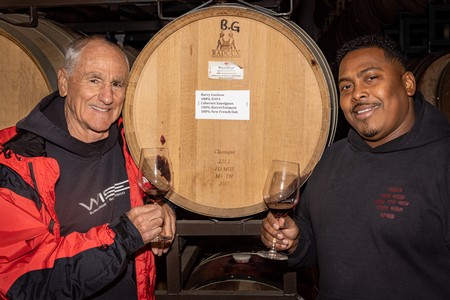
Barry Gnekow with Klinker Brick winemaker Joseph Smith (right), with a new French oak barrel in which a Cabernet Sauvignon that went through the flash-détente process was both fermented and aged
"It is never a black-and-white decision with Flash Détente — in with the good, out with the bad stuff, which you may or may not want to be there. It's just another winemaker's tool to apply in certain areas that you may choose to change or improve. Take, for example, eucalyptus trees, which are used as windbreaks around vineyards all over California, including Lodi. The problem is that the smell of eucalyptus is so strong, it can easily mask the natural fruit qualities of grapes. You want a wine to smell like fruit, not eucalyptus. But since the trees are there, it's no one's fault that the smell is there. It's more a matter of what you can do about it, and you can mitigate a lot of the problems having to do with a vineyard or its surroundings with the use of flash."
Ironically, many California wine lovers used to laud the Heitz Cellar Martha's Vineyard Napa Valley Cabernet Sauvignons from the 1960s and 1970s because of its strong minty/eucalyptus character — sensory notes most California winemakers today would rather avoid like a plague. The open "secret" was that the factor distinguishing the old Martha's Vineyard wines was not so much the vineyard site itself, but rather the eucalyptus trees growing next to it, inundating the air with their scent and oil.
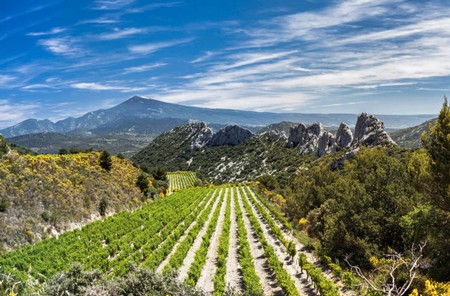
Typical vineyard in Southern France surrounded by slopes covered with wild scrub called garrigue, long known to play much a part in the taste of these wines as the grapes and vines themselves.
Gnekow's concept of air-roir, arrived through the use of Flash Détente, also underlines the basic premise behind the lavendery/juniper/thyme-like variations of garrigue long associated with countless wines grown in France's vast Provence and Languedoc regions, which are surrounded by hills dotted with wild thyme, juniper, and lavender. Want to smell garrigue? Simply rub a fresh rosemary twig between your fingers, and you'll find an almost animal-like, resiny, herbal scent sunk into your skin. The same for the distinct scent of scrubby/flinty/briny maquis associated with the wines grown in Corsica, surrounded by the Mediterranean Sea. That combination of wild shrubs (junipers, thyme, rosemary, lavender, rosemary, myrtle, fennel, etc.), sand dune plants, and sea spray is unforgettable, especially when encased in wine.
Here in California, Pinot noir lovers have recently begun to cultivate a deeper appreciation of wines tinged with foresty — sometimes pine-like, sometimes redwoods — reflecting vineyards farmed in wooded areas of Sonoma Coast or Santa Cruz Mountains, whereas Pinot noirs grown in Santa Lucia Highlands typically retain a scent akin to the wild chaparral (manzanitas, sages, sagebrush, oak, sumacs, buckwheats, etc.) growing on the surrounding hills. These are all qualities more than likely derived through the air surrounding the vineyards, rather than factors like soil, climate, topography, etc.
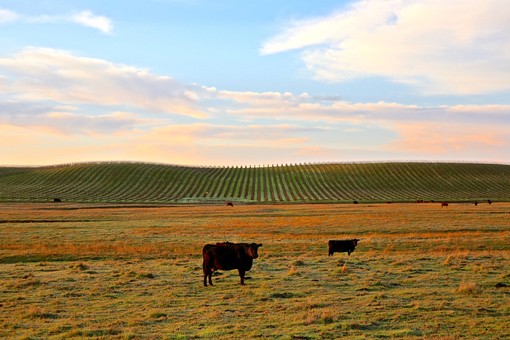
In Lodi's Borden Ranch AVA, cattle grazing among the vineyard blocks within vernal pool areas protected by federal and state laws to support rare endemic plant and animal species
And right here in Lodi, old-time growers have long known that certain old vine Zinfandel blocks — particularly vineyards located on the west and south sides of the City of Lodi — tend to produce wines with strongly earthy, loamy, occasionally compost-like qualities mixed in with that marvelous wild berry aroma of Zinfandel. No one really likes to talk about it, but it's no coincidence that these happen to be the vineyards located closest to the area's many dairies.
The start and proliferation of Flash Détente in California
In talking about the history of the Flash Détente's usage in Lodi, Gnekow couches his experience in terms of the numerous challenges he has met as a winemaker: "The story goes back to 1976 when I was an assistant winemaker at J. Lohr. After a short time, I wanted to get out and travel, but I didn't have the money to do it on my own. So I went out looking for jobs and ended up getting offers in places like South Africa, New Zealand, and Australia. It was like taking my winemaking career out on the road, starting in 1979.
"While I was gone J. Lohr started having serious problems with some of their wines, so I returned to take over the winemaking in 1981. One of the problems was that their Cabernet Sauvignon had what was called the 'Monterey veggies' [because of the cold climate in Monterey County, vineyards planted during the 1970s produced Cabernet Sauvignon grapes that were so green, subsequent wines tasted more like vegetables — i.e., asparagus or bell peppers — than fruit-driven wines].
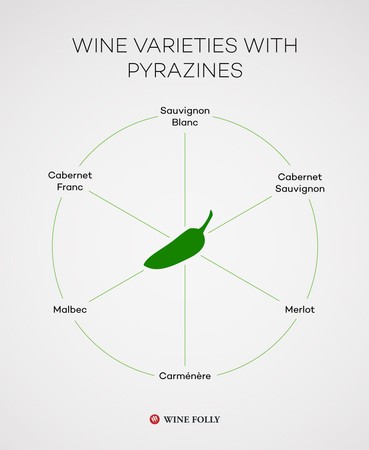
While methoxypyrazines (i.e., the smell of bell peppers and other vegetables) is an aromatic compound found naturally in grapes like Cabernet Sauvignon, in underripe grapes it is detrimental to the expression of fruit — hence, the increasing usage of technology like Flash Détente to mitigate its effects in resulting wines (graphic courtesy of Wine Folly)
"What really saved the J. Lohr brand at the time was that they got approached by the Hyatt hotels to produce house wines for the entire chain. I went out looking for Cabernet Sauvignon for the program, which was when I discovered Paso Robles. Their Cabernet was turning up #1 in our blind tastings, and I told Gary Eberle [co-owner/winemaker of Estrella River Winery, at the time Paso Robles' largest producer of Cabernet Sauvignon] that he probably couldn't plant enough Cabernet, the grape grew so well in that region.
"But I always had scars from dealing with those 'veggie' problems we had with Monterey Cabernet, way back when. In 2009 Rick Jones [a widely respected Napa Valley-based consulting winemaker] came to me with what he called 'flash waters' taken from a machine called Flash Détente being used in Bordeaux in France. I smelled the waters and said holy moly, it's full of methoxypyrazines [a class of chemical compounds naturally found in high amounts in grapes like Cabernet Sauvignon and Sauvignon blanc, giving those varieties strong vegetable-like aromas and flavors].
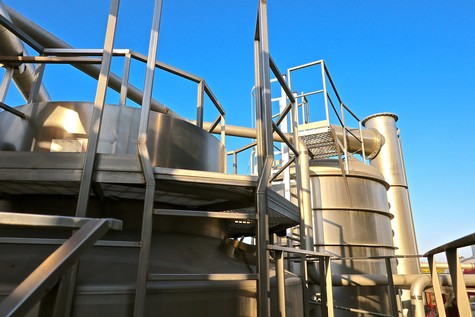
At Lodi Vintners, the flash-détente must heating unit (left) and vacuum chamber manufactured by Della Toffola
"Right away I could see that the Bordelais were using technology to remove bell pepper compounds from their wines. At the time I was also consulting with Hahn Estate in Monterey, so I got Nicky Hahn (Hahn Estate owner) to contact Steve McIntyre [of McIntyre Vineyards, but at the time a partner at Monterey Wine Company, a King City-based custom-crush facility], and together they brought in a Flash Détente, which they started using right away on 500 tons of fruit brought in for the 2009 harvest. Believe it or not, the very first grapes they put through their machine were some Cinsaut from Bechthold Vineyard [a historic vineyard planted on Lodi's west side in 1886].
"The second Flash Détente brought over to the United States was installed the following year, in 2010, and that was right here in Lodi. We immediately started using it for grapes like Zinfandel, which are often picked with grapes with extreme variations — clusters that often have green, underripe berries at the top, and overripe, raisined berries at the bottom. We realized that the machine can effect molecular changes that can address issues like green or raisined qualities by removing the less desirable compounds, which often keep the more positive fruit qualities from shining through."
In 2010 there were just two Flash Détente machines operating in California. "Now I think there are about a dozen units operating in the state," says Gnekow. "There is another one in Monterey, one in Carneros and one in Sonoma Valley, a 'secret one' at a well-known winery in St. Helena, E. & J. Gallo has one in Livingston, Kendall-Jackson has one in Geyserville, Michael David now has their own out on W. Kettleman Lane, and there is a portable unit floating around out there.
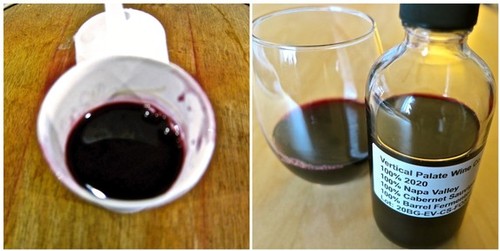
Flash-détente processed Cabernet Sauvignon being barrel fermented (left), and a barrel sample of 2020 Cabernet Sauvignon that was relieved of its smoke taint after three passes through the Flash Détente at Lodi Vintners
"Although it was used in Europe long before we got our units in California, the manufacturer says there has been a resurgence in interest in the technology in Europe after they've seen the way it's been applied in California. The big benefit is that it helps make wines more approachable early on in the bottle. As they say, 90% of wine sales on a Saturday are consumed on a Saturday night. Not too many of the famous European wineries will openly talk about using it, but one exception is the Perrin family at Château de Beaucastel in Châteauneuf-du-Pape — you can find it right there in their own literature!
"The positives of Flash Détente that we've found in Lodi is that it allows us to achieve what we are calling a 'Vertical Palate' [Gnekow now operates his consulting and production firm under the name of Vertical Palate Wine Co.] — the sensation of a wine that feels like it is going through the roof of the mouth, almost like a sparkling wine without the bubbles.
"The Vertical Palate process starts with the use of Flash Détente, which extracts a pure flavor of the grape, free from masking compounds, along with more intense color and tannin — our analyses show that flashed wines have two to three times more phenolic compounds than traditionally processed wines. The 'vertical' sensations come through the use of three separate components: flashed wines that are barrel fermented, flashed wines fermented in large concrete tanks, and flashed wines fermented in stainless steel and then transferred to oak barrels."
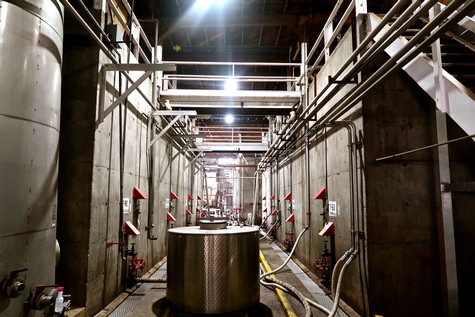
At Lodi Vintners, 20,000 to 32,000-gallon cement tanks (originated installed in the 1940s) are now put to use as a key part of Vertical Wine Co.'s patented winemaking regimen
Notes on 2020 flash glasses of water and Vertical Palate Wine Co. sculpted barrel samples
To demonstrate the efficacy of the flash-détente process, Gnekow offered samplings of both flash waters and subsequent wines from grapes picked in 2020. The wines are all currently aging in French oak barrels. The following are my notes on two of the several examples shown by Gnekow.
The first, coming from a high-elevation Atlas Peak-Napa Valley vineyard that experienced detectable smoke taint from the 2020 wildfires, was sent through the Flash Détente three times. The flash waters from all three passes definitely showed some serious issues from not just smoke from the Glass Fire, which came within 2 miles of the vineyard, but also some methoxypyrazine (the smell of bell pepper). The reason why this wine was even made, explained Gnekow, was because it came from the vineyard's younger vines, just in their fourth leaf, which was not covered by insurance. Fruit from the rest of the vineyard, from the older vines, went unpicked, having been rejected by the wineries:
2020 Napa Valley/Atlas Peak AVA Cabernet Sauvignon
Flash waters
First pass: Like fruit juice soaked in charcoal briquettes, with some green pepper notes
Second pass: Smellier than the first pass water, like dirty river water
Third pass: More pungent bell pepper smell than in the waters from the first two passes, with a little less dirty ashtray smell
A barrel sample of Atlas Peak AVA Cabernet Sauvignon (barrel fermented/currently aging in new French oak): Opaque purplish red color; luscious, almost sweet, concentrated fruit aroma, teeming with berry qualities; full, round velvety palate-feel with a core of firm, muscular tannin — plus, almost miraculously free of smoke taint, as well as the "veggies"
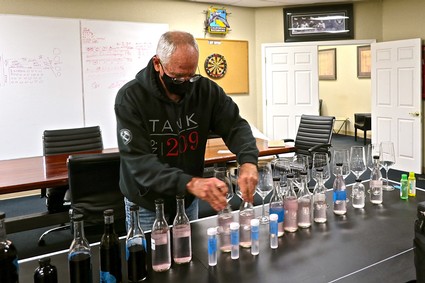
Barry Gnekow laying out flash water samples from the 2020 vintage
This second sampling proffered by Gnekow was also flashed three times. Gnekow explained that this vineyard is located alongside a high-traffic highway, hence typically plagued by smells derived from car exhaust trapped in the air. In addition, there are eucalyptus trees in the area, besides the fact that this is also a cooler climate pocket of Napa Valley, which tends to produce Cabernet Sauvignon fruit with higher proportions of methoxypyrazine. My notes:
2020 Napa Valley/American Canyon Cabernet Sauvignon
Flash waters
First pass: Dirty dish rag/car exhaust smells
Second pass: Similar to the first pass, leaning more toward the car exhaust smell
Third pass: Even smokier/dirty ashtray smell
Barrel sample of American Canyon Cabernet Sauvignon (barrel fermented/aged in new French oak): Deep purplish ruby color; bright, high-toned red berry aroma, slightly floral; firm, zesty, moderately weighted and even-keeled feel with sturdy tannin structure — overall, coming up fresh and very fruit focused
Overall conclusion: It is almost startling what Gnekow and his winemaking team at Lodi Vintners can do with what may have started off as seriously flawed fruit. The two resulting examples of Cabernet Sauvignon currently resting in barrels would easily qualify for a $35 to $55-retail-level wine — they're that good — whereas if they were left "as is," without going through flash-détente three times over, they would have barely been good enough for $5-level wines.
Gnekow makes no bones about what this is all about. "I always tell young winemakers," says Gnekow, "don't believe your own press releases — all the talk about perfect vineyards, pristine grapes, state-of-the-art wineries, and so forth. Our real job as winemakers is to solve problems, and most grapes, and most years, come with more than one problem or another. All the same, our job is to get wine into a bottle so that it tastes good!"
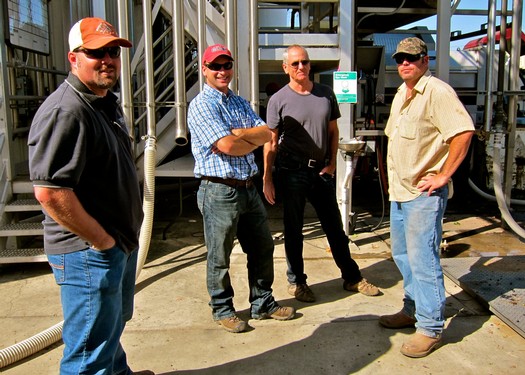
Barry Gnekow (third) with the winemaking/winegrowing team at Lodi's Michael David Winery, another winery that has benefited enormously from Mr. Gnekow's technical knowledge and experience